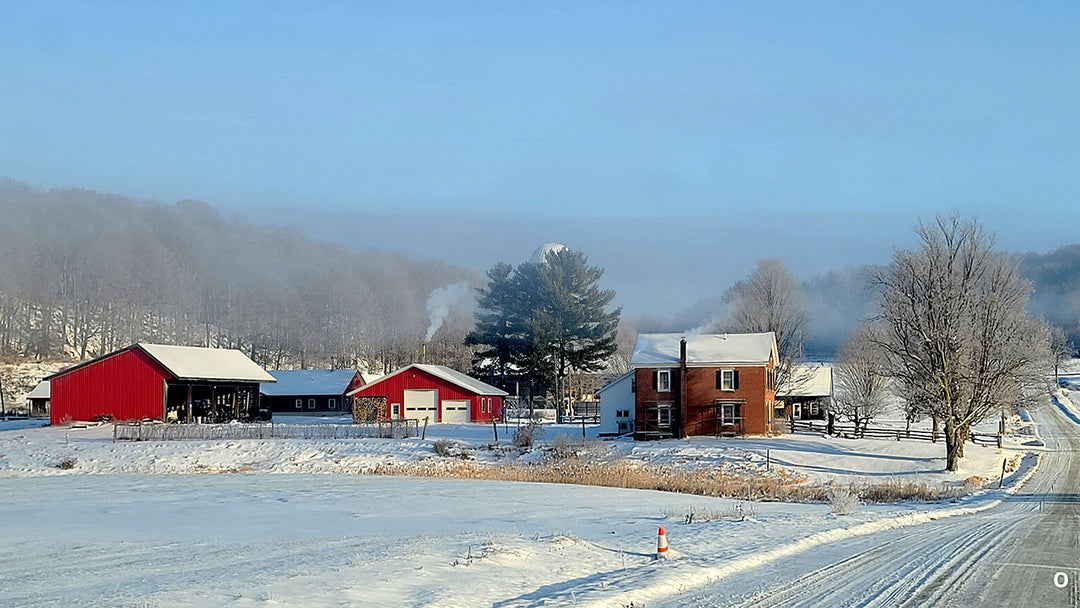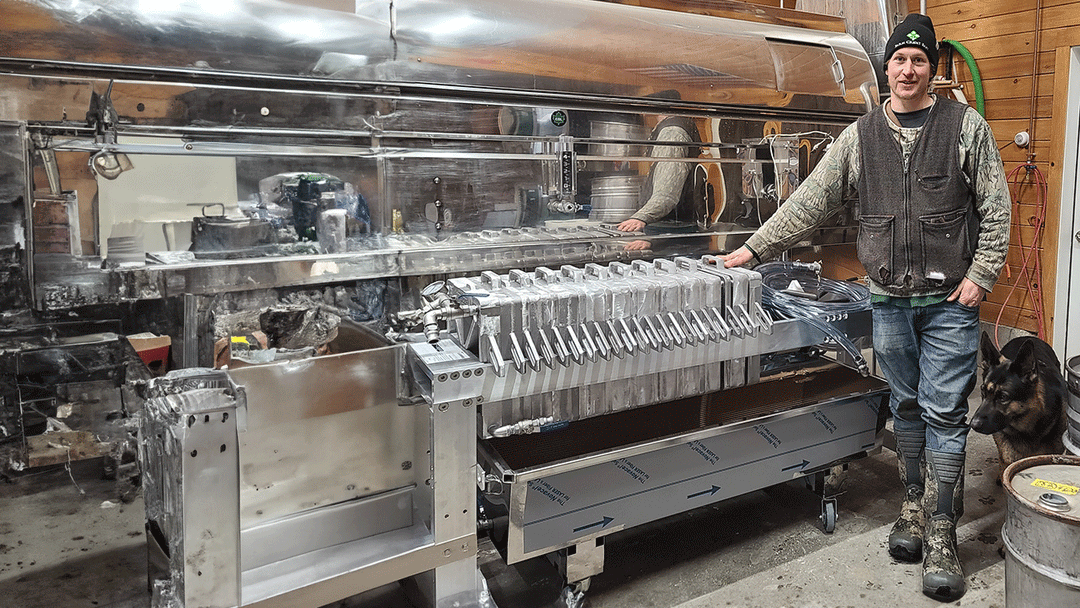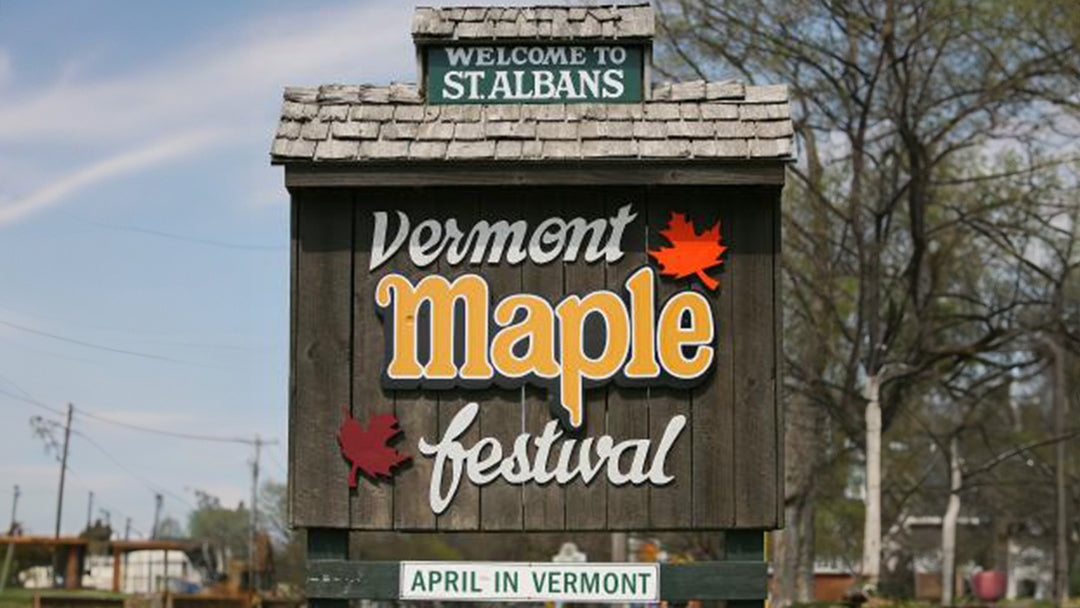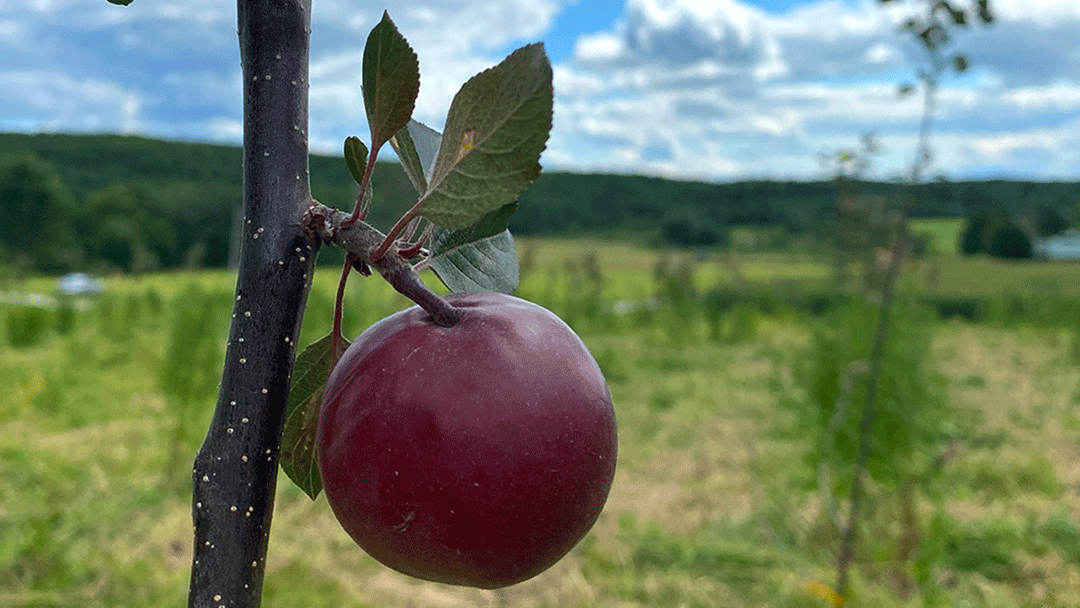How Maple Syrup is Made
Welcome back to our series of blog posts about all things maple syrup from Carman Brook Farm. Today, we're turning our attention to a product that has become an integral part of our farm: real maple syrup.
Pure maple syrup is a natural sweetener, made by boiling down and concentrating the sap of maple trees. This process transforms the sap into a golden, delicious syrup that has delighted taste buds around the world. But there's more to this sweet treat than meets the eye. Behind every drop of real maple syrup lies a process that's both fascinating and complex, a process we'll explore in this post.
Since its early days, Carman Brook Farm has grown and evolved over the generations. Initially known for dairy farming, our family expanded into maple syrup production in 1999. This step wasn't just about adding another agricultural commodity. It was a strategic decision to diversify, a response to the myriad of challenges that come with farming and having all of your, "eggs in one basket" so to say. The addition of maple syrup to our farm's activities proved to be a successful move, adding resilience to our small family farm.
In the following sections, we'll guide you through the entire process of making maple syrup. We'll explain how we turn sap into syrup, what influences the quantity of sap needed, and where the majority of maple syrup production takes place. We'll also touch upon the different grades of maple syrup, helping you understand their unique characteristics.
So, without further ado, let's step into the world of real maple syrup.
The Origin of Maple Syrup
Stepping into the world of maple syrup isn't just about understanding how to produce maple syrup, but also appreciating the sweet history that comes with it.

Photo from the Library of Congress
The art of making maple syrup is steeped in rich cultural traditions. Long before the European settlers arrived in North America, the indigenous peoples were already harvesting and boiling the sap of maple trees. However, they weren't producing the syrup we're familiar with today. Instead, they boiled the sap until it crystallized into granulated sugar—a product we now know as maple sugar.

Why maple sugar, you might ask? It was a practical choice. Maple sugar was shelf-stable, could be stored for long periods of time, and was less costly than the cane sugar shipped from the East and West Indies. This sweet substitute was adopted and widely used by early North American settlers as a daily sweetener.
The story of how maple sugar transformed into the syrup we love today is a tale of innovation and modernization. As canning techniques improved over time, it became possible to store food items safely for extended periods. This development led to the production of maple syrup in its current, pourable form—a sweet delight that found its way from our breakfast tables to our favorite recipes.
Fast-forwarding to the present, the United States is home to several prominent maple syrup regions, with Vermont at the forefront. Known for its vibrant fall colors and cold temperatures in the winter, Vermont's unique climate makes it a fertile ground for maple trees. Today, it stands proudly as the number one producer of maple syrup in the United States, contributing significantly to the country's syrup supply.
However, maple syrup isn't just a North American specialty. The art of sap-to-syrup transformation has made its way across the globe. Canada has emerged as the world's largest producer, with the province of Quebec producing most of the world's maple syrup. Overseas, countries like Poland, Ukraine, and Russia also contribute to global production, although on a smaller scale.
The Main Ingredient: Maple Sap
As we dive deeper into the world of maple, it's time to turn our attention to its star ingredient: maple sap. This slightly sweet liquid, flowing through the cambium of sugar maple trees, is the very essence that gives maple syrup its unique flavor. But what exactly is this tree sap and how does it form the foundation of our syrup production?

Maple sap is essentially the tree's lifeblood. It carries essential nutrients from the limbs to the roots, ensuring growth and development. In the winter, the trees store starch in their branches and roots. When the spring thaw arrives, and temperatures rise above freezing during the day but dip below freezing at night, this starch gets converted to sugar and then mixes with the groundwater absorbed by the tree. This sugar water, or sap, then travels through the tree, and it's at this time we collect the surplus.
At Carman Brook Farm, we've always made it our priority to harvest this sap sustainably. We take great care to ensure the health and longevity of our trees and follow strict guidelines to keep our practices eco-friendly. A key rule we follow is not to place more than two taps in a tree, and then in only mature, larger trees. For a tree to be considered mature, and ready to share its sap with us, it should be about 40 years old, or at least 8 inches in diameter. This is just one of the many ways we maintain the balance between production and preservation, the tree needs to be healthy enough to heal the tap hole quickly. If you're curious to learn more about our tapping process, feel free to check out our detailed blog post on how to tap a maple tree.
One interesting aspect of sap harvesting is the variation in sap's sugar content, which changes from year to year. This fluctuation is influenced by various environmental factors affecting tree health. For instance, a dry summer can reduce a tree's water uptake, while pests like the spongy moth can defoliate trees, leading to lower sap sugar levels. Despite these challenges, nature finds a way, and each season offers a unique harvest.
How Much Sap Does It Take To Make Maple Syrup?
An often-asked question by maple syrup enthusiasts is, "Just how much sap does it take to make maple syrup?" The short answer is: quite a lot! However, as with many aspects of nature, the details can be a bit more complex.
On average, it takes about 40 gallons of sap to make just 1 gallon of maple syrup. This is because sap straight from the tree is about 98% water and only about 2% sugar. This sugar is what eventually concentrates to form the syrup we all love, but getting to that point involves removing a lot of water.
This ratio can vary from year to year. As we've discussed earlier, environmental factors such as the weather, tree health, and pest activity can all influence the sugar content of the sap. In some years, it may take more than 40 gallons of sap to produce a gallon of syrup, while in others it could take slightly less.

At Carman Brook Farm, we strive to make our syrup production as efficient and sustainable as possible. One way we do this is by using a technique known as reverse osmosis. This process allows us to remove a substantial portion of the water from the sap before we even start boiling. As a result, we can drastically reduce the amount of energy—typically provided by fossil fuels—needed to turn sap into syrup. You can learn more about this process in our accompanying blog post about reverse osmosis.
By adopting sustainable practices like reverse osmosis, we not only make our production process more efficient but also reduce our environmental impact. And while the amount of sap needed to make maple syrup can fluctuate, our commitment to producing high-quality, sustainable maple syrup remains constant.
The Process: From Tree To Bottle
Transforming maple sap into real maple syrup is a simple, but engaging process that requires both care and skill. It begins in the living tissue of the maple tree and ends in the bottles you find on our farm shelves. Let's walk through this process step by step.

Tapping the Trees
The first step in making maple syrup is tapping the trees. This involves drilling a small hole in the trunk of a mature maple tree and inserting a spout (or tap). We use a drill bit of about 1/4" in diameter to minimize damage to the tree. These taps need to be placed new each season and removed at the end of the season to allow the tree to heal and prevent contamination. At Carman Brook Farm, we pay particular attention to the placement of these taps, working our way around the tree over the years. By the time we come back to the original location, the tree has healed over the old wounds with new growth.

Collecting the Sap
Once the trees are tapped, the next step is to collect the sap. We have a system set up of recyclable plastic tubing that carries the sap from the trees directly to our sugarhouse. This system uses both gravity and vacuum to help transport the sap to holding tanks at the sugarhouse. With the sugarhouse located at the lowest point on our farm, we're able to efficiently collect sap without the need for transporting it by truck.

Concentration and Boiling
When the sap reaches our sugarhouse, it's time for concentration and boiling. We first use reverse osmosis to remove a large portion of the water content, which greatly reduces the amount of time and energy required for boiling. Before the advent of reverse osmosis, sugarmakers would work long into the night during a 'sap run'—those peak times when the sap flow is high.

Filtration and Finishing
After boiling, the next step is filtration and finishing. We filter our syrup using diatomaceous earth—a naturally occurring sedimentary rock that crumbles into a fine white powder. This material is excellent for filtering out any impurities or 'niter' (sugar sand) that might be present in the syrup. Once filtered, the syrup is stored in 40-gallon drums, ready for the final step.

Bottling and Packaging
The final step in our process is bottling and packaging. Throughout the year, we select the best-tasting barrels of pure Vermont maple syrup produced on our farm for bottling. Our syrup is carefully hot packed into a variety of bottles, and we also craft other products such as maple cream and maple candy. Each bottle or product we produce is a testament to our passion for creating high-quality, sustainable maple products.

The Different Grades of Maple Syrup
Another intriguing facet of maple syrup production is the different grades of syrup we obtain. Most supermarket syrup is blended together to make one homogenous type. In reality, each grade is unique, characterized by its color, translucency, and flavor profile. These varying attributes provide an array of options for both culinary applications and taste preferences. Let's dive into the details of each grade:

Golden Delicate Taste: This is the lightest and often first syrup of the season. With its clear, golden color transmitting greater than or equal to 75% of light, it offers a delicate and subtle maple flavor. Hints of vanilla, baked apple, praline, and fresh butter delicately dance on the palate, creating a truly exquisite tasting experience.

Amber Rich Taste: Harvested during the early to mid-season, this syrup showcases a warm, amber hue, transmitting between 50.0 to 74.9% of light. The flavor is a bit more pronounced, with undertones of bourbon, nutmeg, crème brûlée, and oats. The rich maple taste makes this grade a popular choice for drizzling over pancakes or adding to oatmeal.

Dark Robust Taste: As we move into the mid to late sugaring season, the syrup deepens in both color and flavor. This dark amber syrup, transmitting 25.0 to 49.9% of light, presents a robust maple flavor. With hints of prunes, butterscotch, and cinnamon, this grade offers a more intense maple experience.

Very Dark Strong Taste: Produced late in the season, this syrup is the darkest, transmitting less than 25% of light. Its intense, full-bodied flavor features overtones of toffee, apricot, and coffee. This grade is favored in baking, where its strong taste stands out even amidst other robust ingredients.

You may wonder, what influences the grade of the syrup? It turns out that the answer lies in natural processes and timing. As the season progresses, the warming temperatures stimulate naturally occurring bacteria within the tree to convert sucrose into fructose and glucose. These simpler sugars brown more readily under heat, causing the syrup to darken. This change not only affects the color but also deepens the flavor profile, hence leading to different grades. For an in-depth understanding, please refer to our blog post on maple syrup grades.
Frequently Asked Questions About Maple Syrup
Navigating the intricate world of maple syrup can spark quite a few questions. Here, we've gathered some of the most frequently asked ones. We hope that by addressing these, we can further deepen your appreciation of maple syrup.
How long can I store my maple syrup, and how should I store it?

Maple syrup, if properly stored, can last for a considerable time. An unopened bottle can sit in a cool, dark place for up to two years. Once opened, it should be kept refrigerated and ideally used within a year. And if you're thinking about longer-term storage, freezing your maple syrup is also a viable option, given that it doesn't solidify due to its high sugar content. For more detailed guidance, refer to our blog post on How to Store Maple Syrup.
What are the health benefits of maple syrup?

Beyond its delightful sweetness, maple syrup houses a wealth of antioxidants and minerals such as manganese and zinc, all of which contribute to a robust immune system. As a natural sweetener, it can form part of a balanced diet when used mindfully. For a more comprehensive discussion on its health benefits, please visit our blog post, Is Maple Syrup Good for You?
Is maple syrup only used for pancakes and waffles?

Far from it! While it's a beloved classic for pancakes and waffles, maple syrup is a perfect replacement for white refined sugar. It can be a sweet note in baked goods, a unique addition to marinades and salad dressings, and a natural sweetener for your coffee or tea. Its diverse grades open up a spectrum of culinary uses. Explore our Maple Recipes blog for some inspiring ways to incorporate maple syrup into your cooking and baking.
Can any type of maple tree be used for maple syrup production?

Sap can technically be collected from any maple species, but Sugar Maple (Acer saccharum) is preferred due to its high sugar content. Other types like Black, Silver, and Red Maple are also tapped, but usually have a lower sugar concentration in their sap, affecting both taste and yield. For a more in-depth explanation, including the fascinating physiology of maple trees, visit our blog post on How to Tap a Maple Tree.
How can I tell if my maple syrup has gone bad?

While maple syrup is quite durable, improper storage can lead to spoilage. Signs include the presence of mold, an off smell, or changes in texture. If you notice any of these, it's safer to discard the syrup. For more tips on storage and indications of spoilage, refer to our blog post on How to Store Maple Syrup.
In Conclusion
We hope these answers help demystify the many aspects of producing maple syrup. If you have a question or topic you'd like us to explore, drop a comment below and we'll explore it. We're always eager to share our knowledge and passion for all things maple.
We hope this post has given you a fresh appreciation of the hard work, passion, and tradition that goes into creating a bottle of pure, flavorful maple syrup. From understanding the complex life of maple trees to the careful process of sap collection, concentration, and boiling, it's clear that producing maple syrup is as much an art as it is a science.

Want to further immerse yourself in the world of maple syrup? Don’t forget to share this post with your friends and loved ones. Exploring our other blog posts can give you even more insight into this sweet universe. And of course, visiting our online store will give you access to all of our maple products, each crafted with care and dedication.






Leave a comment